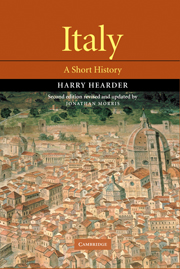Book contents
- Frontmatter
- Contents
- List of illustrations
- Preface
- 1 Italy in the classical world
- 2 The early Middle Ages
- 3 The high Middle Ages
- 4 The Renaissance
- 5 The political and cultural eclipse of Italy
- 6 The Risorgimento, 1790–1861
- 7 From Unification to Fascism, 1861–1922
- 8 The Fascist disaster, 1922–45
- 9 Italy since the Second World War, 1945–80
- Epilogue: From the First to the Second Republic: Italy 1980–2001
- A brief guide to further reading
- Index
6 - The Risorgimento, 1790–1861
Published online by Cambridge University Press: 05 February 2015
- Frontmatter
- Contents
- List of illustrations
- Preface
- 1 Italy in the classical world
- 2 The early Middle Ages
- 3 The high Middle Ages
- 4 The Renaissance
- 5 The political and cultural eclipse of Italy
- 6 The Risorgimento, 1790–1861
- 7 From Unification to Fascism, 1861–1922
- 8 The Fascist disaster, 1922–45
- 9 Italy since the Second World War, 1945–80
- Epilogue: From the First to the Second Republic: Italy 1980–2001
- A brief guide to further reading
- Index
Summary
The Napoleonic and Restoration eras, 1790–1821
Eighteenth-century Italy had been the source of many enlightened political ideas, but the concept of national sovereignty had not been one of them. The monarch, whether the Habsburg emperor, the pope or a grand duke, had been generally accepted as the sovereign. The idea that the people were sovereign had been vaguely present in classical days – with their ‘Senate and People of Rome’ – but it had not survived into the Middle Ages. It had been revived in the eighteenth century by Rousseau and the many French pamphleteers whose ideas could be traced back to Rousseau. In Italy the ‘ideas of 1789’ were not a native product, but they were quickly adopted by men who were recognized as ‘Jacobins’, a term which raised strong passions, whether it was used for praise or abuse.
Wars in modern times have usually had an ideological element attached to them, if only offered as an excuse for less noble reasons, or as a propaganda facade to encourage the unfortunate people who have to fight the war. The war which started in 1792 between revolutionary France on the one hand, and the Austrian and Prussian monarchies on the other, had a larger ideological element than most wars. In such a war Piedmont would have been a natural enemy of revolutionary France, even if she had not been strategically placed in the front line of resistance to this strange new force which had been hurled at the world by the citizens of Paris.
- Type
- Chapter
- Information
- ItalyA Short History, pp. 153 - 197Publisher: Cambridge University PressPrint publication year: 2001

